Analysis of Business Functions Integration at Tesco
VerifiedAdded on 2022/12/14
|12
|4148
|60
Report
AI Summary
This report provides a comprehensive analysis of Tesco's business functions, exploring its strategic approaches, leadership practices, and the integration of various business aspects. The report begins with an overview of Tesco's history and its position in the retail sector, emphasizing its commitment to quality service and consumer relations. It then delves into Tesco's strategic evolution, including its pricing policies, diversification strategies, and customer-centric approaches. A SWOT analysis is presented to evaluate Tesco's strengths, weaknesses, opportunities, and threats, followed by an application of Porter's Five Forces model to assess the competitive environment within the retail industry. The report also examines Tesco's leadership practices, highlighting its reliance on democratic leadership to foster employee engagement and enhance customer satisfaction. The analysis covers various aspects of Tesco's business operations, aiming to provide insights into its success and adaptability in a dynamic market environment. The report concludes with a discussion of the key factors contributing to Tesco's performance and its ability to maintain a competitive edge in the global retail landscape.
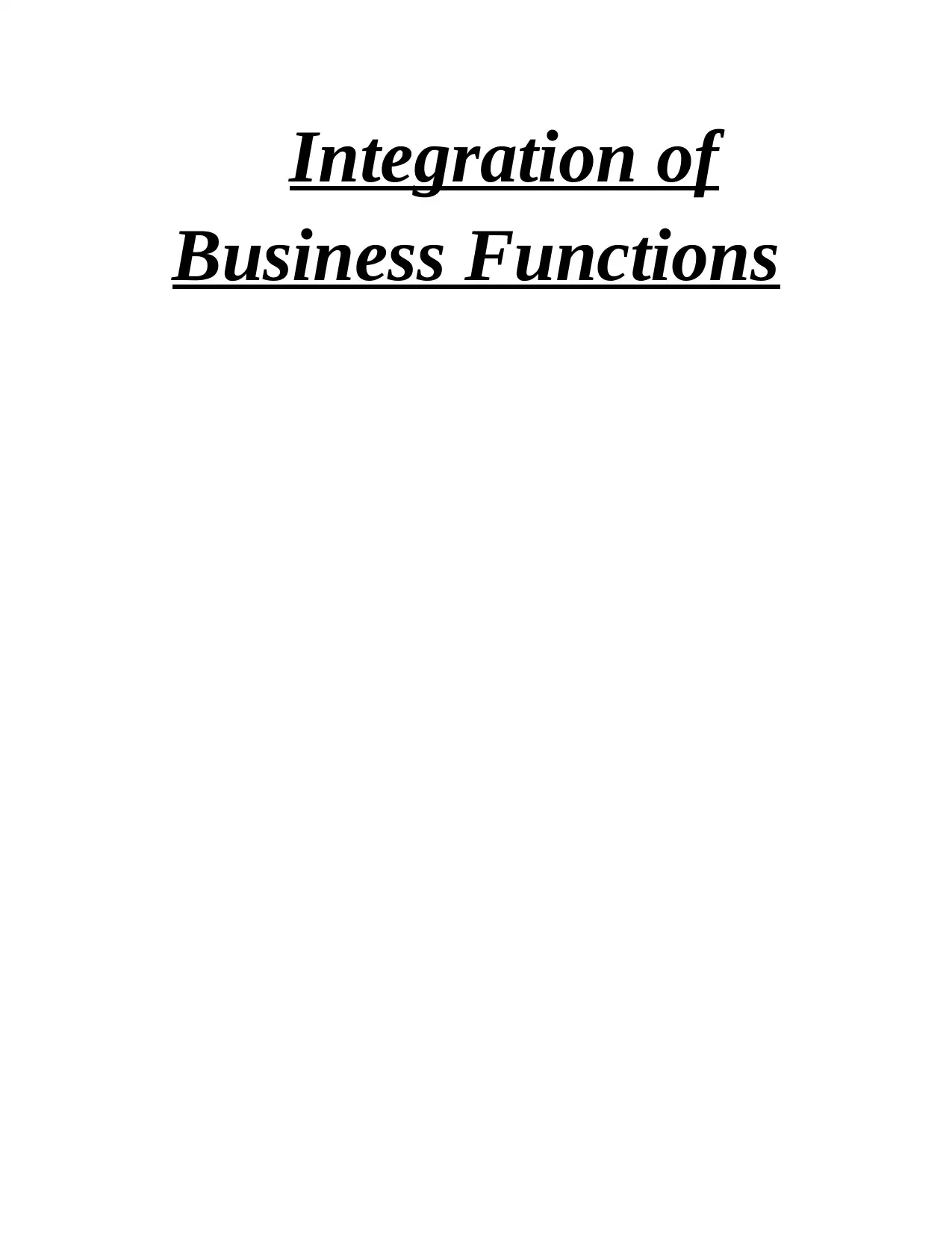
Integration of
Business Functions
Business Functions
Paraphrase This Document
Need a fresh take? Get an instant paraphrase of this document with our AI Paraphraser
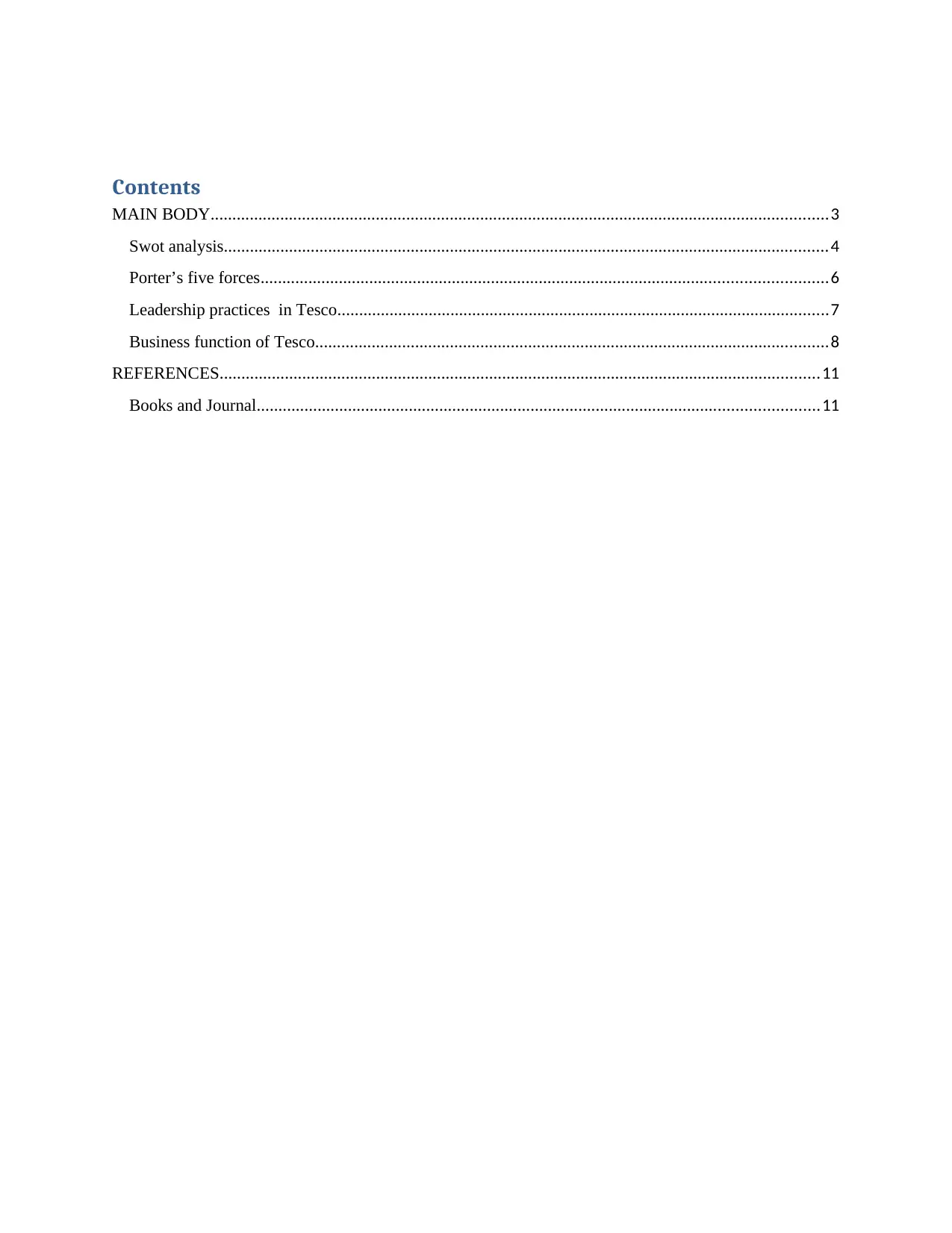
Contents
MAIN BODY..............................................................................................................................................3
Swot analysis...........................................................................................................................................4
Porter’s five forces..................................................................................................................................6
Leadership practices in Tesco.................................................................................................................7
Business function of Tesco......................................................................................................................8
REFERENCES..........................................................................................................................................11
Books and Journal.................................................................................................................................11
MAIN BODY..............................................................................................................................................3
Swot analysis...........................................................................................................................................4
Porter’s five forces..................................................................................................................................6
Leadership practices in Tesco.................................................................................................................7
Business function of Tesco......................................................................................................................8
REFERENCES..........................................................................................................................................11
Books and Journal.................................................................................................................................11
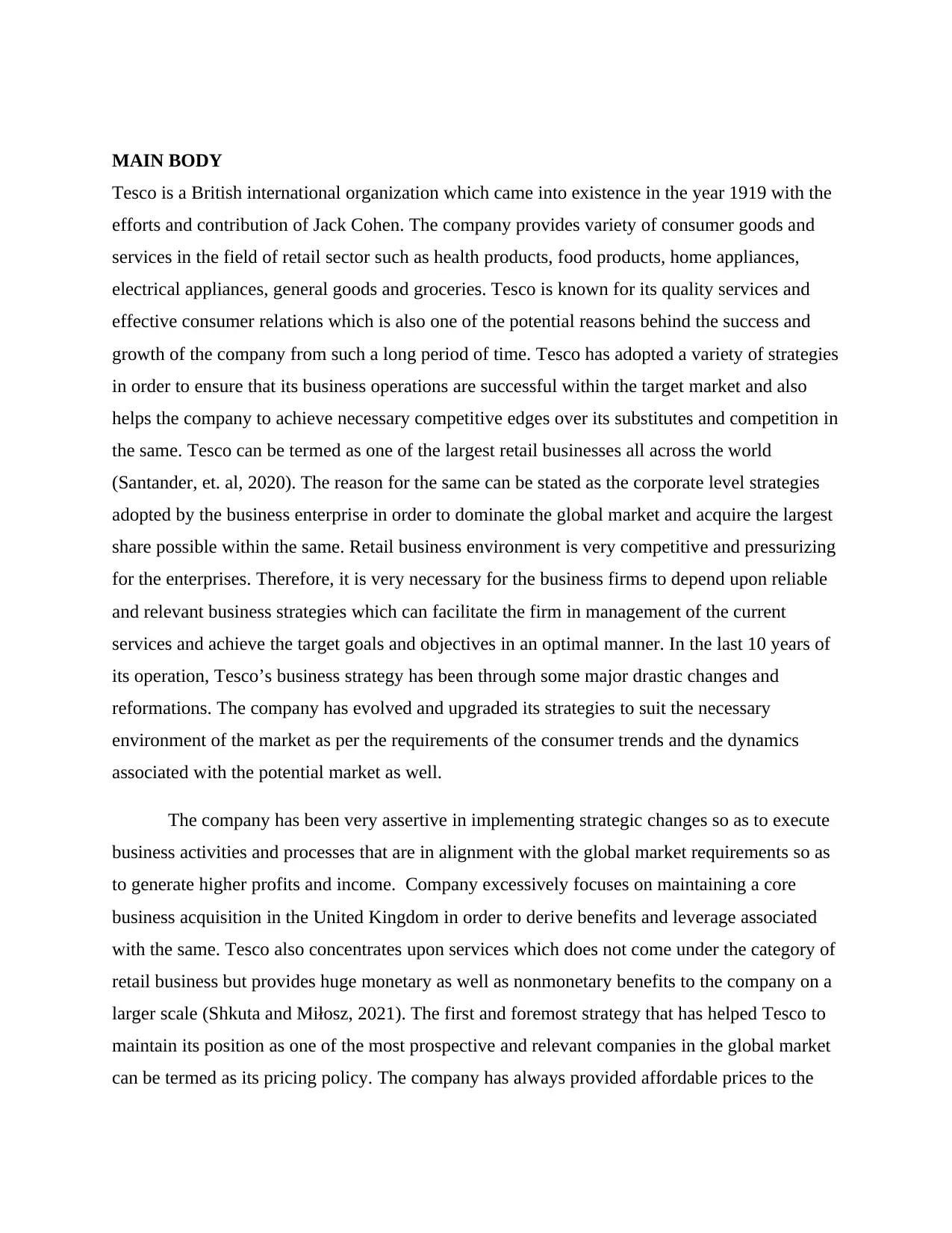
MAIN BODY
Tesco is a British international organization which came into existence in the year 1919 with the
efforts and contribution of Jack Cohen. The company provides variety of consumer goods and
services in the field of retail sector such as health products, food products, home appliances,
electrical appliances, general goods and groceries. Tesco is known for its quality services and
effective consumer relations which is also one of the potential reasons behind the success and
growth of the company from such a long period of time. Tesco has adopted a variety of strategies
in order to ensure that its business operations are successful within the target market and also
helps the company to achieve necessary competitive edges over its substitutes and competition in
the same. Tesco can be termed as one of the largest retail businesses all across the world
(Santander, et. al, 2020). The reason for the same can be stated as the corporate level strategies
adopted by the business enterprise in order to dominate the global market and acquire the largest
share possible within the same. Retail business environment is very competitive and pressurizing
for the enterprises. Therefore, it is very necessary for the business firms to depend upon reliable
and relevant business strategies which can facilitate the firm in management of the current
services and achieve the target goals and objectives in an optimal manner. In the last 10 years of
its operation, Tesco’s business strategy has been through some major drastic changes and
reformations. The company has evolved and upgraded its strategies to suit the necessary
environment of the market as per the requirements of the consumer trends and the dynamics
associated with the potential market as well.
The company has been very assertive in implementing strategic changes so as to execute
business activities and processes that are in alignment with the global market requirements so as
to generate higher profits and income. Company excessively focuses on maintaining a core
business acquisition in the United Kingdom in order to derive benefits and leverage associated
with the same. Tesco also concentrates upon services which does not come under the category of
retail business but provides huge monetary as well as nonmonetary benefits to the company on a
larger scale (Shkuta and Miłosz, 2021). The first and foremost strategy that has helped Tesco to
maintain its position as one of the most prospective and relevant companies in the global market
can be termed as its pricing policy. The company has always provided affordable prices to the
Tesco is a British international organization which came into existence in the year 1919 with the
efforts and contribution of Jack Cohen. The company provides variety of consumer goods and
services in the field of retail sector such as health products, food products, home appliances,
electrical appliances, general goods and groceries. Tesco is known for its quality services and
effective consumer relations which is also one of the potential reasons behind the success and
growth of the company from such a long period of time. Tesco has adopted a variety of strategies
in order to ensure that its business operations are successful within the target market and also
helps the company to achieve necessary competitive edges over its substitutes and competition in
the same. Tesco can be termed as one of the largest retail businesses all across the world
(Santander, et. al, 2020). The reason for the same can be stated as the corporate level strategies
adopted by the business enterprise in order to dominate the global market and acquire the largest
share possible within the same. Retail business environment is very competitive and pressurizing
for the enterprises. Therefore, it is very necessary for the business firms to depend upon reliable
and relevant business strategies which can facilitate the firm in management of the current
services and achieve the target goals and objectives in an optimal manner. In the last 10 years of
its operation, Tesco’s business strategy has been through some major drastic changes and
reformations. The company has evolved and upgraded its strategies to suit the necessary
environment of the market as per the requirements of the consumer trends and the dynamics
associated with the potential market as well.
The company has been very assertive in implementing strategic changes so as to execute
business activities and processes that are in alignment with the global market requirements so as
to generate higher profits and income. Company excessively focuses on maintaining a core
business acquisition in the United Kingdom in order to derive benefits and leverage associated
with the same. Tesco also concentrates upon services which does not come under the category of
retail business but provides huge monetary as well as nonmonetary benefits to the company on a
larger scale (Shkuta and Miłosz, 2021). The first and foremost strategy that has helped Tesco to
maintain its position as one of the most prospective and relevant companies in the global market
can be termed as its pricing policy. The company has always provided affordable prices to the
⊘ This is a preview!⊘
Do you want full access?
Subscribe today to unlock all pages.

Trusted by 1+ million students worldwide
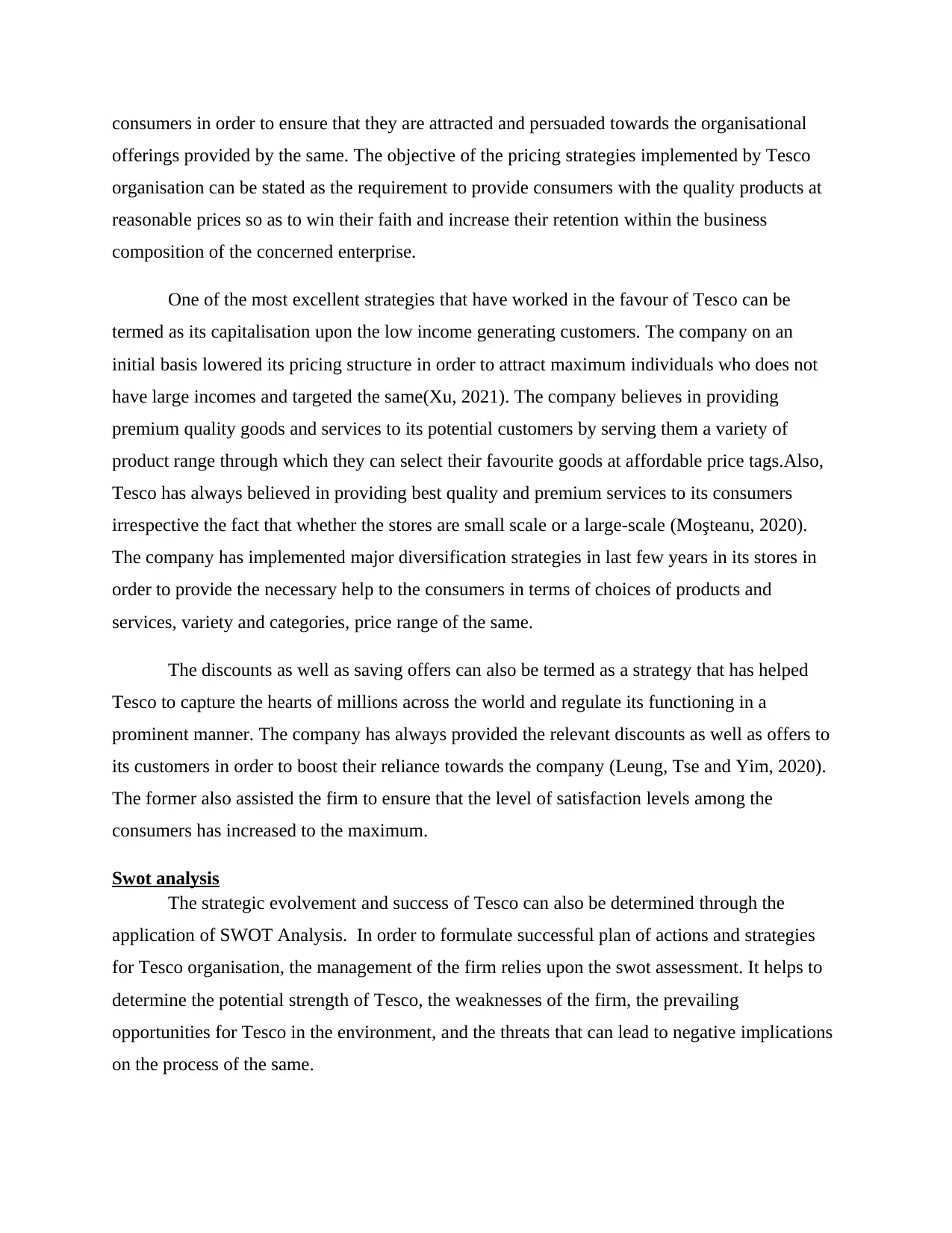
consumers in order to ensure that they are attracted and persuaded towards the organisational
offerings provided by the same. The objective of the pricing strategies implemented by Tesco
organisation can be stated as the requirement to provide consumers with the quality products at
reasonable prices so as to win their faith and increase their retention within the business
composition of the concerned enterprise.
One of the most excellent strategies that have worked in the favour of Tesco can be
termed as its capitalisation upon the low income generating customers. The company on an
initial basis lowered its pricing structure in order to attract maximum individuals who does not
have large incomes and targeted the same(Xu, 2021). The company believes in providing
premium quality goods and services to its potential customers by serving them a variety of
product range through which they can select their favourite goods at affordable price tags.Also,
Tesco has always believed in providing best quality and premium services to its consumers
irrespective the fact that whether the stores are small scale or a large-scale (Moşteanu, 2020).
The company has implemented major diversification strategies in last few years in its stores in
order to provide the necessary help to the consumers in terms of choices of products and
services, variety and categories, price range of the same.
The discounts as well as saving offers can also be termed as a strategy that has helped
Tesco to capture the hearts of millions across the world and regulate its functioning in a
prominent manner. The company has always provided the relevant discounts as well as offers to
its customers in order to boost their reliance towards the company (Leung, Tse and Yim, 2020).
The former also assisted the firm to ensure that the level of satisfaction levels among the
consumers has increased to the maximum.
Swot analysis
The strategic evolvement and success of Tesco can also be determined through the
application of SWOT Analysis. In order to formulate successful plan of actions and strategies
for Tesco organisation, the management of the firm relies upon the swot assessment. It helps to
determine the potential strength of Tesco, the weaknesses of the firm, the prevailing
opportunities for Tesco in the environment, and the threats that can lead to negative implications
on the process of the same.
offerings provided by the same. The objective of the pricing strategies implemented by Tesco
organisation can be stated as the requirement to provide consumers with the quality products at
reasonable prices so as to win their faith and increase their retention within the business
composition of the concerned enterprise.
One of the most excellent strategies that have worked in the favour of Tesco can be
termed as its capitalisation upon the low income generating customers. The company on an
initial basis lowered its pricing structure in order to attract maximum individuals who does not
have large incomes and targeted the same(Xu, 2021). The company believes in providing
premium quality goods and services to its potential customers by serving them a variety of
product range through which they can select their favourite goods at affordable price tags.Also,
Tesco has always believed in providing best quality and premium services to its consumers
irrespective the fact that whether the stores are small scale or a large-scale (Moşteanu, 2020).
The company has implemented major diversification strategies in last few years in its stores in
order to provide the necessary help to the consumers in terms of choices of products and
services, variety and categories, price range of the same.
The discounts as well as saving offers can also be termed as a strategy that has helped
Tesco to capture the hearts of millions across the world and regulate its functioning in a
prominent manner. The company has always provided the relevant discounts as well as offers to
its customers in order to boost their reliance towards the company (Leung, Tse and Yim, 2020).
The former also assisted the firm to ensure that the level of satisfaction levels among the
consumers has increased to the maximum.
Swot analysis
The strategic evolvement and success of Tesco can also be determined through the
application of SWOT Analysis. In order to formulate successful plan of actions and strategies
for Tesco organisation, the management of the firm relies upon the swot assessment. It helps to
determine the potential strength of Tesco, the weaknesses of the firm, the prevailing
opportunities for Tesco in the environment, and the threats that can lead to negative implications
on the process of the same.
Paraphrase This Document
Need a fresh take? Get an instant paraphrase of this document with our AI Paraphraser
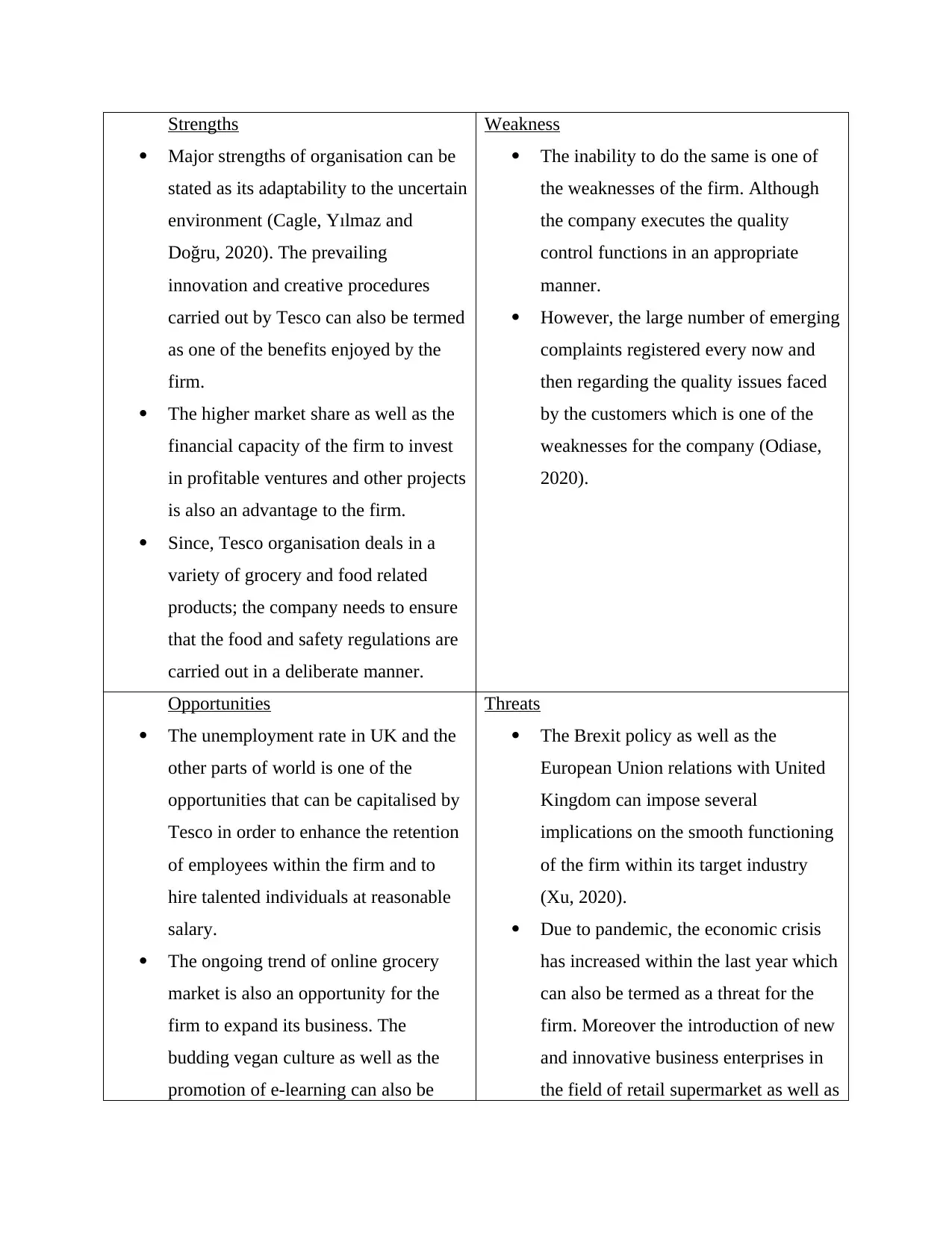
Strengths
Major strengths of organisation can be
stated as its adaptability to the uncertain
environment (Cagle, Yılmaz and
Doğru, 2020). The prevailing
innovation and creative procedures
carried out by Tesco can also be termed
as one of the benefits enjoyed by the
firm.
The higher market share as well as the
financial capacity of the firm to invest
in profitable ventures and other projects
is also an advantage to the firm.
Since, Tesco organisation deals in a
variety of grocery and food related
products; the company needs to ensure
that the food and safety regulations are
carried out in a deliberate manner.
Weakness
The inability to do the same is one of
the weaknesses of the firm. Although
the company executes the quality
control functions in an appropriate
manner.
However, the large number of emerging
complaints registered every now and
then regarding the quality issues faced
by the customers which is one of the
weaknesses for the company (Odiase,
2020).
Opportunities
The unemployment rate in UK and the
other parts of world is one of the
opportunities that can be capitalised by
Tesco in order to enhance the retention
of employees within the firm and to
hire talented individuals at reasonable
salary.
The ongoing trend of online grocery
market is also an opportunity for the
firm to expand its business. The
budding vegan culture as well as the
promotion of e-learning can also be
Threats
The Brexit policy as well as the
European Union relations with United
Kingdom can impose several
implications on the smooth functioning
of the firm within its target industry
(Xu, 2020).
Due to pandemic, the economic crisis
has increased within the last year which
can also be termed as a threat for the
firm. Moreover the introduction of new
and innovative business enterprises in
the field of retail supermarket as well as
Major strengths of organisation can be
stated as its adaptability to the uncertain
environment (Cagle, Yılmaz and
Doğru, 2020). The prevailing
innovation and creative procedures
carried out by Tesco can also be termed
as one of the benefits enjoyed by the
firm.
The higher market share as well as the
financial capacity of the firm to invest
in profitable ventures and other projects
is also an advantage to the firm.
Since, Tesco organisation deals in a
variety of grocery and food related
products; the company needs to ensure
that the food and safety regulations are
carried out in a deliberate manner.
Weakness
The inability to do the same is one of
the weaknesses of the firm. Although
the company executes the quality
control functions in an appropriate
manner.
However, the large number of emerging
complaints registered every now and
then regarding the quality issues faced
by the customers which is one of the
weaknesses for the company (Odiase,
2020).
Opportunities
The unemployment rate in UK and the
other parts of world is one of the
opportunities that can be capitalised by
Tesco in order to enhance the retention
of employees within the firm and to
hire talented individuals at reasonable
salary.
The ongoing trend of online grocery
market is also an opportunity for the
firm to expand its business. The
budding vegan culture as well as the
promotion of e-learning can also be
Threats
The Brexit policy as well as the
European Union relations with United
Kingdom can impose several
implications on the smooth functioning
of the firm within its target industry
(Xu, 2020).
Due to pandemic, the economic crisis
has increased within the last year which
can also be termed as a threat for the
firm. Moreover the introduction of new
and innovative business enterprises in
the field of retail supermarket as well as
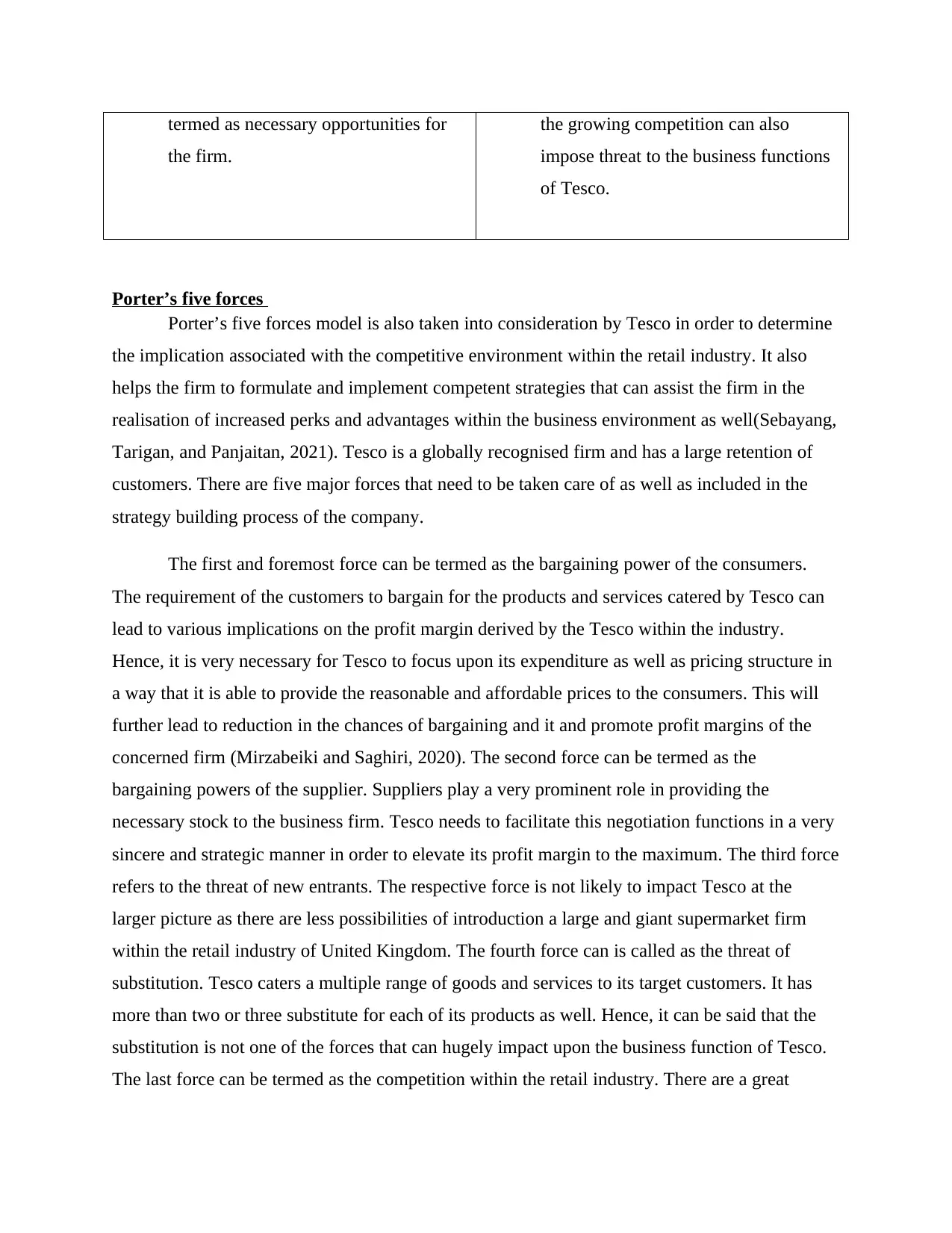
termed as necessary opportunities for
the firm.
the growing competition can also
impose threat to the business functions
of Tesco.
Porter’s five forces
Porter’s five forces model is also taken into consideration by Tesco in order to determine
the implication associated with the competitive environment within the retail industry. It also
helps the firm to formulate and implement competent strategies that can assist the firm in the
realisation of increased perks and advantages within the business environment as well(Sebayang,
Tarigan, and Panjaitan, 2021). Tesco is a globally recognised firm and has a large retention of
customers. There are five major forces that need to be taken care of as well as included in the
strategy building process of the company.
The first and foremost force can be termed as the bargaining power of the consumers.
The requirement of the customers to bargain for the products and services catered by Tesco can
lead to various implications on the profit margin derived by the Tesco within the industry.
Hence, it is very necessary for Tesco to focus upon its expenditure as well as pricing structure in
a way that it is able to provide the reasonable and affordable prices to the consumers. This will
further lead to reduction in the chances of bargaining and it and promote profit margins of the
concerned firm (Mirzabeiki and Saghiri, 2020). The second force can be termed as the
bargaining powers of the supplier. Suppliers play a very prominent role in providing the
necessary stock to the business firm. Tesco needs to facilitate this negotiation functions in a very
sincere and strategic manner in order to elevate its profit margin to the maximum. The third force
refers to the threat of new entrants. The respective force is not likely to impact Tesco at the
larger picture as there are less possibilities of introduction a large and giant supermarket firm
within the retail industry of United Kingdom. The fourth force can is called as the threat of
substitution. Tesco caters a multiple range of goods and services to its target customers. It has
more than two or three substitute for each of its products as well. Hence, it can be said that the
substitution is not one of the forces that can hugely impact upon the business function of Tesco.
The last force can be termed as the competition within the retail industry. There are a great
the firm.
the growing competition can also
impose threat to the business functions
of Tesco.
Porter’s five forces
Porter’s five forces model is also taken into consideration by Tesco in order to determine
the implication associated with the competitive environment within the retail industry. It also
helps the firm to formulate and implement competent strategies that can assist the firm in the
realisation of increased perks and advantages within the business environment as well(Sebayang,
Tarigan, and Panjaitan, 2021). Tesco is a globally recognised firm and has a large retention of
customers. There are five major forces that need to be taken care of as well as included in the
strategy building process of the company.
The first and foremost force can be termed as the bargaining power of the consumers.
The requirement of the customers to bargain for the products and services catered by Tesco can
lead to various implications on the profit margin derived by the Tesco within the industry.
Hence, it is very necessary for Tesco to focus upon its expenditure as well as pricing structure in
a way that it is able to provide the reasonable and affordable prices to the consumers. This will
further lead to reduction in the chances of bargaining and it and promote profit margins of the
concerned firm (Mirzabeiki and Saghiri, 2020). The second force can be termed as the
bargaining powers of the supplier. Suppliers play a very prominent role in providing the
necessary stock to the business firm. Tesco needs to facilitate this negotiation functions in a very
sincere and strategic manner in order to elevate its profit margin to the maximum. The third force
refers to the threat of new entrants. The respective force is not likely to impact Tesco at the
larger picture as there are less possibilities of introduction a large and giant supermarket firm
within the retail industry of United Kingdom. The fourth force can is called as the threat of
substitution. Tesco caters a multiple range of goods and services to its target customers. It has
more than two or three substitute for each of its products as well. Hence, it can be said that the
substitution is not one of the forces that can hugely impact upon the business function of Tesco.
The last force can be termed as the competition within the retail industry. There are a great
⊘ This is a preview!⊘
Do you want full access?
Subscribe today to unlock all pages.

Trusted by 1+ million students worldwide
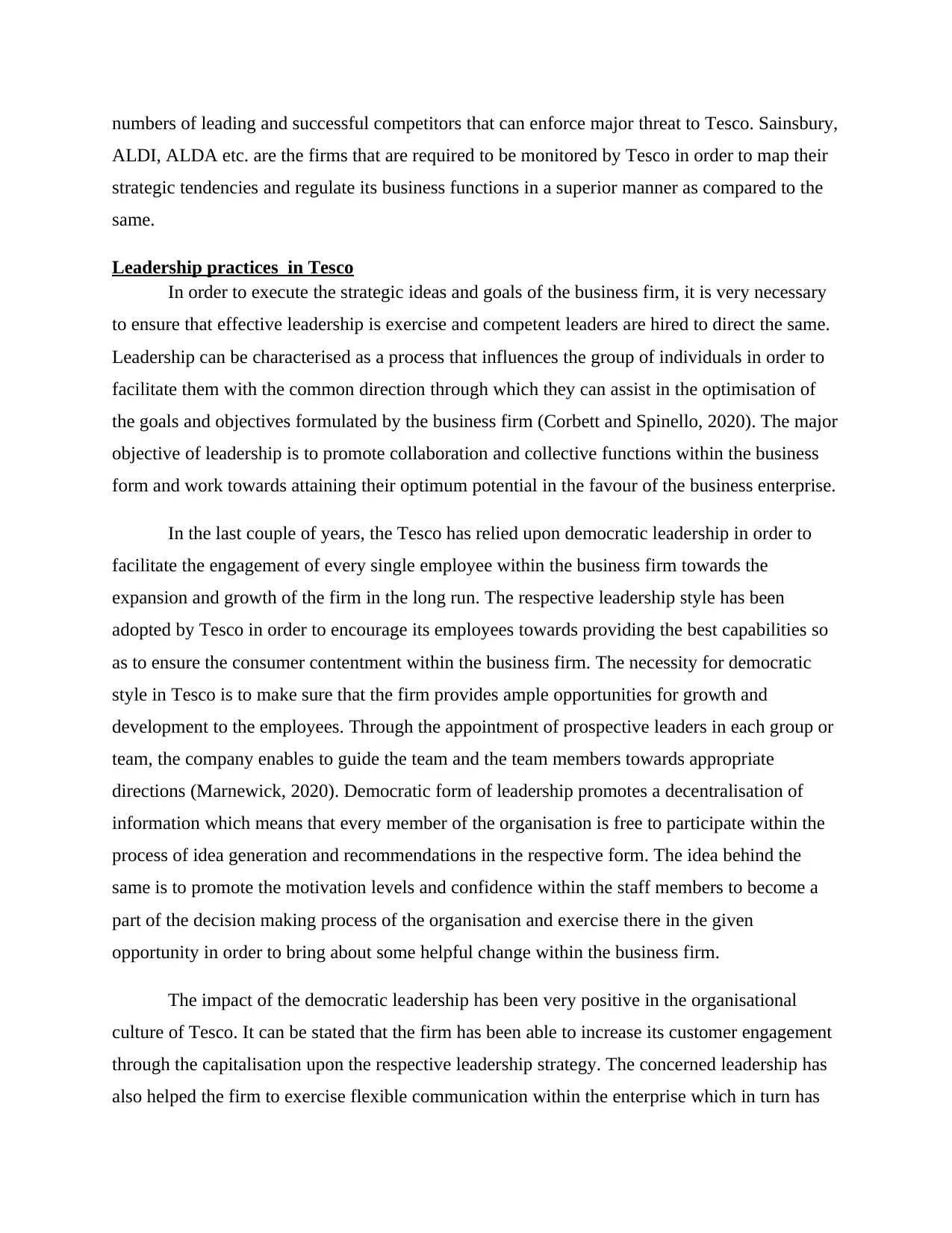
numbers of leading and successful competitors that can enforce major threat to Tesco. Sainsbury,
ALDI, ALDA etc. are the firms that are required to be monitored by Tesco in order to map their
strategic tendencies and regulate its business functions in a superior manner as compared to the
same.
Leadership practices in Tesco
In order to execute the strategic ideas and goals of the business firm, it is very necessary
to ensure that effective leadership is exercise and competent leaders are hired to direct the same.
Leadership can be characterised as a process that influences the group of individuals in order to
facilitate them with the common direction through which they can assist in the optimisation of
the goals and objectives formulated by the business firm (Corbett and Spinello, 2020). The major
objective of leadership is to promote collaboration and collective functions within the business
form and work towards attaining their optimum potential in the favour of the business enterprise.
In the last couple of years, the Tesco has relied upon democratic leadership in order to
facilitate the engagement of every single employee within the business firm towards the
expansion and growth of the firm in the long run. The respective leadership style has been
adopted by Tesco in order to encourage its employees towards providing the best capabilities so
as to ensure the consumer contentment within the business firm. The necessity for democratic
style in Tesco is to make sure that the firm provides ample opportunities for growth and
development to the employees. Through the appointment of prospective leaders in each group or
team, the company enables to guide the team and the team members towards appropriate
directions (Marnewick, 2020). Democratic form of leadership promotes a decentralisation of
information which means that every member of the organisation is free to participate within the
process of idea generation and recommendations in the respective form. The idea behind the
same is to promote the motivation levels and confidence within the staff members to become a
part of the decision making process of the organisation and exercise there in the given
opportunity in order to bring about some helpful change within the business firm.
The impact of the democratic leadership has been very positive in the organisational
culture of Tesco. It can be stated that the firm has been able to increase its customer engagement
through the capitalisation upon the respective leadership strategy. The concerned leadership has
also helped the firm to exercise flexible communication within the enterprise which in turn has
ALDI, ALDA etc. are the firms that are required to be monitored by Tesco in order to map their
strategic tendencies and regulate its business functions in a superior manner as compared to the
same.
Leadership practices in Tesco
In order to execute the strategic ideas and goals of the business firm, it is very necessary
to ensure that effective leadership is exercise and competent leaders are hired to direct the same.
Leadership can be characterised as a process that influences the group of individuals in order to
facilitate them with the common direction through which they can assist in the optimisation of
the goals and objectives formulated by the business firm (Corbett and Spinello, 2020). The major
objective of leadership is to promote collaboration and collective functions within the business
form and work towards attaining their optimum potential in the favour of the business enterprise.
In the last couple of years, the Tesco has relied upon democratic leadership in order to
facilitate the engagement of every single employee within the business firm towards the
expansion and growth of the firm in the long run. The respective leadership style has been
adopted by Tesco in order to encourage its employees towards providing the best capabilities so
as to ensure the consumer contentment within the business firm. The necessity for democratic
style in Tesco is to make sure that the firm provides ample opportunities for growth and
development to the employees. Through the appointment of prospective leaders in each group or
team, the company enables to guide the team and the team members towards appropriate
directions (Marnewick, 2020). Democratic form of leadership promotes a decentralisation of
information which means that every member of the organisation is free to participate within the
process of idea generation and recommendations in the respective form. The idea behind the
same is to promote the motivation levels and confidence within the staff members to become a
part of the decision making process of the organisation and exercise there in the given
opportunity in order to bring about some helpful change within the business firm.
The impact of the democratic leadership has been very positive in the organisational
culture of Tesco. It can be stated that the firm has been able to increase its customer engagement
through the capitalisation upon the respective leadership strategy. The concerned leadership has
also helped the firm to exercise flexible communication within the enterprise which in turn has
Paraphrase This Document
Need a fresh take? Get an instant paraphrase of this document with our AI Paraphraser
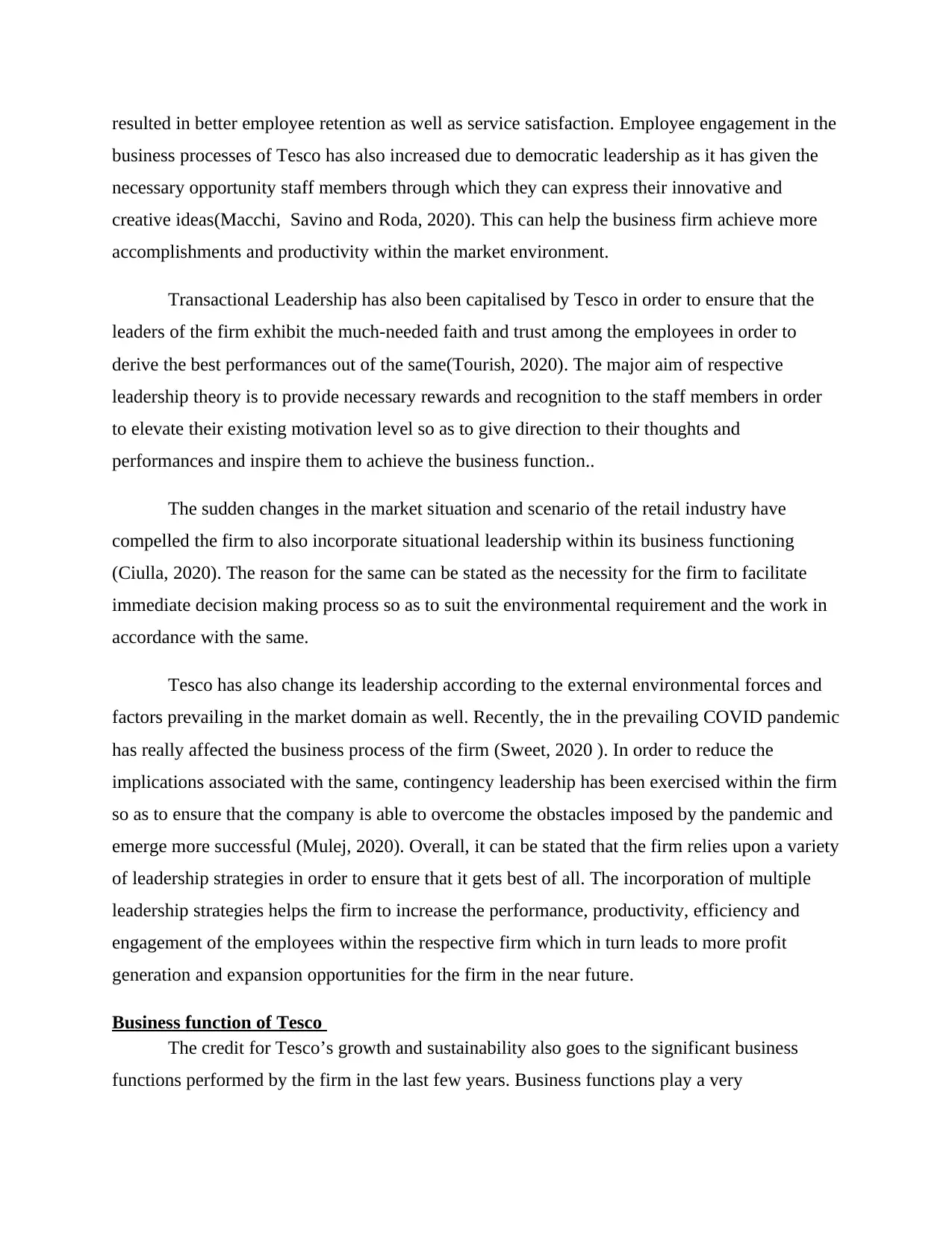
resulted in better employee retention as well as service satisfaction. Employee engagement in the
business processes of Tesco has also increased due to democratic leadership as it has given the
necessary opportunity staff members through which they can express their innovative and
creative ideas(Macchi, Savino and Roda, 2020). This can help the business firm achieve more
accomplishments and productivity within the market environment.
Transactional Leadership has also been capitalised by Tesco in order to ensure that the
leaders of the firm exhibit the much-needed faith and trust among the employees in order to
derive the best performances out of the same(Tourish, 2020). The major aim of respective
leadership theory is to provide necessary rewards and recognition to the staff members in order
to elevate their existing motivation level so as to give direction to their thoughts and
performances and inspire them to achieve the business function..
The sudden changes in the market situation and scenario of the retail industry have
compelled the firm to also incorporate situational leadership within its business functioning
(Ciulla, 2020). The reason for the same can be stated as the necessity for the firm to facilitate
immediate decision making process so as to suit the environmental requirement and the work in
accordance with the same.
Tesco has also change its leadership according to the external environmental forces and
factors prevailing in the market domain as well. Recently, the in the prevailing COVID pandemic
has really affected the business process of the firm (Sweet, 2020 ). In order to reduce the
implications associated with the same, contingency leadership has been exercised within the firm
so as to ensure that the company is able to overcome the obstacles imposed by the pandemic and
emerge more successful (Mulej, 2020). Overall, it can be stated that the firm relies upon a variety
of leadership strategies in order to ensure that it gets best of all. The incorporation of multiple
leadership strategies helps the firm to increase the performance, productivity, efficiency and
engagement of the employees within the respective firm which in turn leads to more profit
generation and expansion opportunities for the firm in the near future.
Business function of Tesco
The credit for Tesco’s growth and sustainability also goes to the significant business
functions performed by the firm in the last few years. Business functions play a very
business processes of Tesco has also increased due to democratic leadership as it has given the
necessary opportunity staff members through which they can express their innovative and
creative ideas(Macchi, Savino and Roda, 2020). This can help the business firm achieve more
accomplishments and productivity within the market environment.
Transactional Leadership has also been capitalised by Tesco in order to ensure that the
leaders of the firm exhibit the much-needed faith and trust among the employees in order to
derive the best performances out of the same(Tourish, 2020). The major aim of respective
leadership theory is to provide necessary rewards and recognition to the staff members in order
to elevate their existing motivation level so as to give direction to their thoughts and
performances and inspire them to achieve the business function..
The sudden changes in the market situation and scenario of the retail industry have
compelled the firm to also incorporate situational leadership within its business functioning
(Ciulla, 2020). The reason for the same can be stated as the necessity for the firm to facilitate
immediate decision making process so as to suit the environmental requirement and the work in
accordance with the same.
Tesco has also change its leadership according to the external environmental forces and
factors prevailing in the market domain as well. Recently, the in the prevailing COVID pandemic
has really affected the business process of the firm (Sweet, 2020 ). In order to reduce the
implications associated with the same, contingency leadership has been exercised within the firm
so as to ensure that the company is able to overcome the obstacles imposed by the pandemic and
emerge more successful (Mulej, 2020). Overall, it can be stated that the firm relies upon a variety
of leadership strategies in order to ensure that it gets best of all. The incorporation of multiple
leadership strategies helps the firm to increase the performance, productivity, efficiency and
engagement of the employees within the respective firm which in turn leads to more profit
generation and expansion opportunities for the firm in the near future.
Business function of Tesco
The credit for Tesco’s growth and sustainability also goes to the significant business
functions performed by the firm in the last few years. Business functions play a very
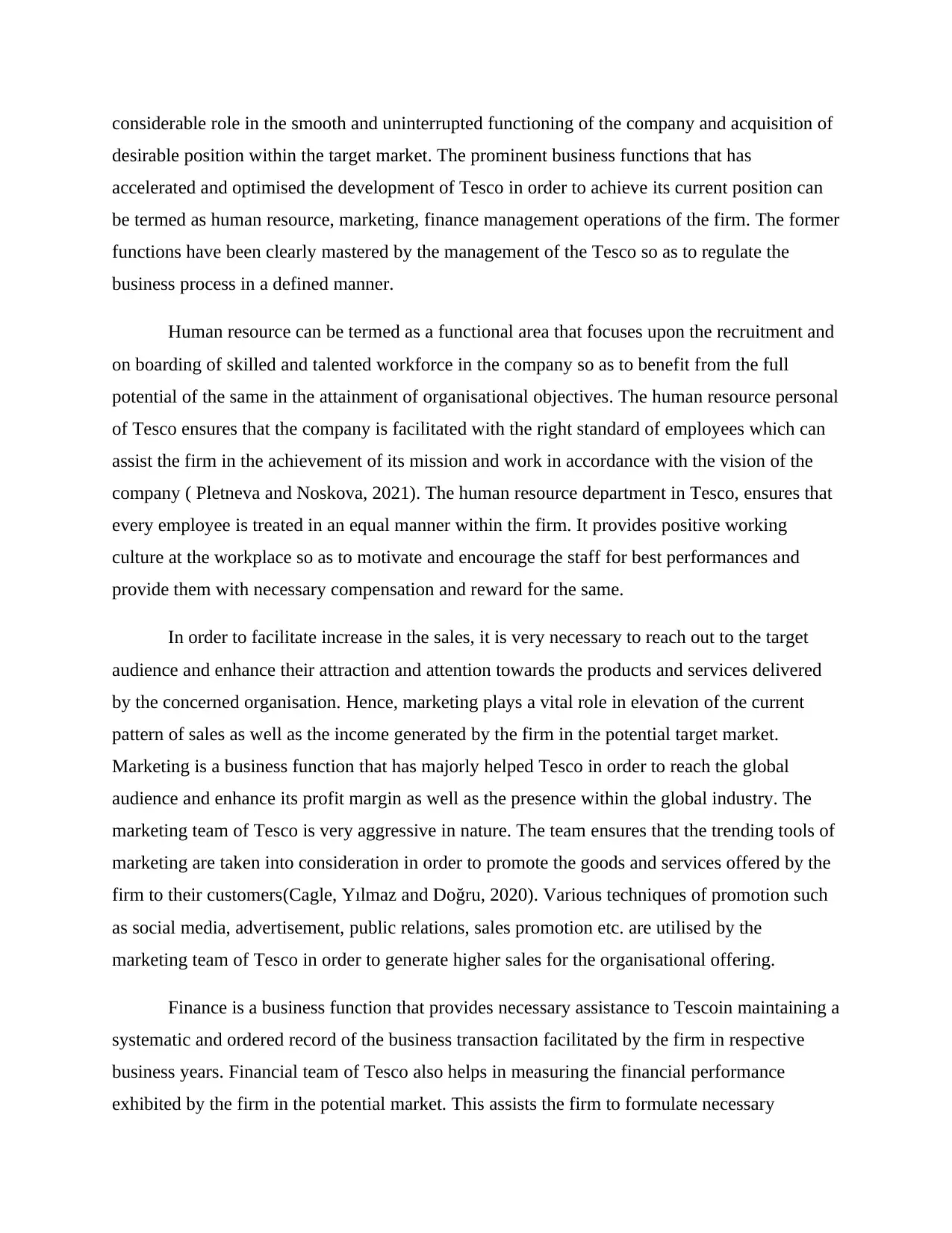
considerable role in the smooth and uninterrupted functioning of the company and acquisition of
desirable position within the target market. The prominent business functions that has
accelerated and optimised the development of Tesco in order to achieve its current position can
be termed as human resource, marketing, finance management operations of the firm. The former
functions have been clearly mastered by the management of the Tesco so as to regulate the
business process in a defined manner.
Human resource can be termed as a functional area that focuses upon the recruitment and
on boarding of skilled and talented workforce in the company so as to benefit from the full
potential of the same in the attainment of organisational objectives. The human resource personal
of Tesco ensures that the company is facilitated with the right standard of employees which can
assist the firm in the achievement of its mission and work in accordance with the vision of the
company ( Pletneva and Noskova, 2021). The human resource department in Tesco, ensures that
every employee is treated in an equal manner within the firm. It provides positive working
culture at the workplace so as to motivate and encourage the staff for best performances and
provide them with necessary compensation and reward for the same.
In order to facilitate increase in the sales, it is very necessary to reach out to the target
audience and enhance their attraction and attention towards the products and services delivered
by the concerned organisation. Hence, marketing plays a vital role in elevation of the current
pattern of sales as well as the income generated by the firm in the potential target market.
Marketing is a business function that has majorly helped Tesco in order to reach the global
audience and enhance its profit margin as well as the presence within the global industry. The
marketing team of Tesco is very aggressive in nature. The team ensures that the trending tools of
marketing are taken into consideration in order to promote the goods and services offered by the
firm to their customers(Cagle, Yılmaz and Doğru, 2020). Various techniques of promotion such
as social media, advertisement, public relations, sales promotion etc. are utilised by the
marketing team of Tesco in order to generate higher sales for the organisational offering.
Finance is a business function that provides necessary assistance to Tescoin maintaining a
systematic and ordered record of the business transaction facilitated by the firm in respective
business years. Financial team of Tesco also helps in measuring the financial performance
exhibited by the firm in the potential market. This assists the firm to formulate necessary
desirable position within the target market. The prominent business functions that has
accelerated and optimised the development of Tesco in order to achieve its current position can
be termed as human resource, marketing, finance management operations of the firm. The former
functions have been clearly mastered by the management of the Tesco so as to regulate the
business process in a defined manner.
Human resource can be termed as a functional area that focuses upon the recruitment and
on boarding of skilled and talented workforce in the company so as to benefit from the full
potential of the same in the attainment of organisational objectives. The human resource personal
of Tesco ensures that the company is facilitated with the right standard of employees which can
assist the firm in the achievement of its mission and work in accordance with the vision of the
company ( Pletneva and Noskova, 2021). The human resource department in Tesco, ensures that
every employee is treated in an equal manner within the firm. It provides positive working
culture at the workplace so as to motivate and encourage the staff for best performances and
provide them with necessary compensation and reward for the same.
In order to facilitate increase in the sales, it is very necessary to reach out to the target
audience and enhance their attraction and attention towards the products and services delivered
by the concerned organisation. Hence, marketing plays a vital role in elevation of the current
pattern of sales as well as the income generated by the firm in the potential target market.
Marketing is a business function that has majorly helped Tesco in order to reach the global
audience and enhance its profit margin as well as the presence within the global industry. The
marketing team of Tesco is very aggressive in nature. The team ensures that the trending tools of
marketing are taken into consideration in order to promote the goods and services offered by the
firm to their customers(Cagle, Yılmaz and Doğru, 2020). Various techniques of promotion such
as social media, advertisement, public relations, sales promotion etc. are utilised by the
marketing team of Tesco in order to generate higher sales for the organisational offering.
Finance is a business function that provides necessary assistance to Tescoin maintaining a
systematic and ordered record of the business transaction facilitated by the firm in respective
business years. Financial team of Tesco also helps in measuring the financial performance
exhibited by the firm in the potential market. This assists the firm to formulate necessary
⊘ This is a preview!⊘
Do you want full access?
Subscribe today to unlock all pages.

Trusted by 1+ million students worldwide
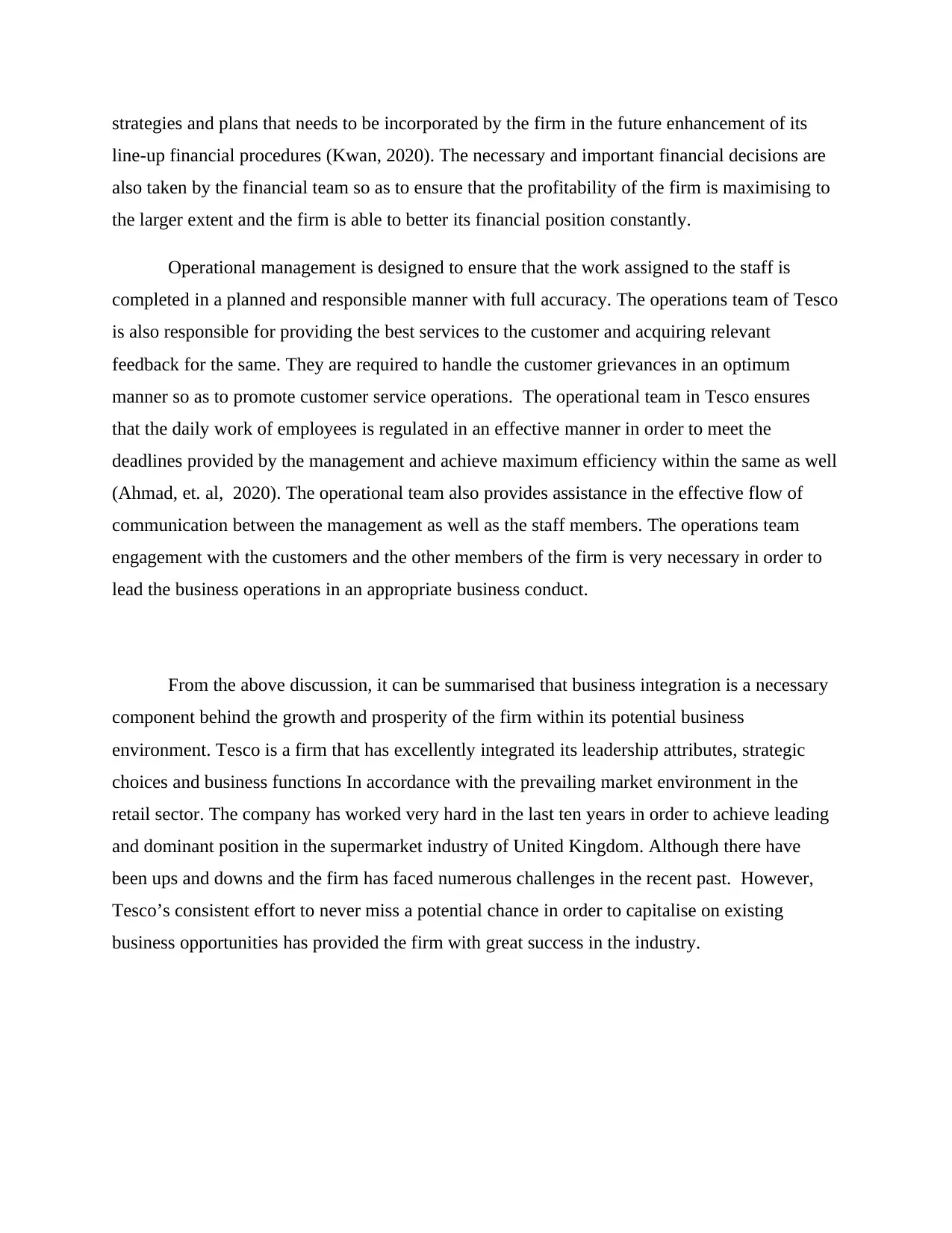
strategies and plans that needs to be incorporated by the firm in the future enhancement of its
line-up financial procedures (Kwan, 2020). The necessary and important financial decisions are
also taken by the financial team so as to ensure that the profitability of the firm is maximising to
the larger extent and the firm is able to better its financial position constantly.
Operational management is designed to ensure that the work assigned to the staff is
completed in a planned and responsible manner with full accuracy. The operations team of Tesco
is also responsible for providing the best services to the customer and acquiring relevant
feedback for the same. They are required to handle the customer grievances in an optimum
manner so as to promote customer service operations. The operational team in Tesco ensures
that the daily work of employees is regulated in an effective manner in order to meet the
deadlines provided by the management and achieve maximum efficiency within the same as well
(Ahmad, et. al, 2020). The operational team also provides assistance in the effective flow of
communication between the management as well as the staff members. The operations team
engagement with the customers and the other members of the firm is very necessary in order to
lead the business operations in an appropriate business conduct.
From the above discussion, it can be summarised that business integration is a necessary
component behind the growth and prosperity of the firm within its potential business
environment. Tesco is a firm that has excellently integrated its leadership attributes, strategic
choices and business functions In accordance with the prevailing market environment in the
retail sector. The company has worked very hard in the last ten years in order to achieve leading
and dominant position in the supermarket industry of United Kingdom. Although there have
been ups and downs and the firm has faced numerous challenges in the recent past. However,
Tesco’s consistent effort to never miss a potential chance in order to capitalise on existing
business opportunities has provided the firm with great success in the industry.
line-up financial procedures (Kwan, 2020). The necessary and important financial decisions are
also taken by the financial team so as to ensure that the profitability of the firm is maximising to
the larger extent and the firm is able to better its financial position constantly.
Operational management is designed to ensure that the work assigned to the staff is
completed in a planned and responsible manner with full accuracy. The operations team of Tesco
is also responsible for providing the best services to the customer and acquiring relevant
feedback for the same. They are required to handle the customer grievances in an optimum
manner so as to promote customer service operations. The operational team in Tesco ensures
that the daily work of employees is regulated in an effective manner in order to meet the
deadlines provided by the management and achieve maximum efficiency within the same as well
(Ahmad, et. al, 2020). The operational team also provides assistance in the effective flow of
communication between the management as well as the staff members. The operations team
engagement with the customers and the other members of the firm is very necessary in order to
lead the business operations in an appropriate business conduct.
From the above discussion, it can be summarised that business integration is a necessary
component behind the growth and prosperity of the firm within its potential business
environment. Tesco is a firm that has excellently integrated its leadership attributes, strategic
choices and business functions In accordance with the prevailing market environment in the
retail sector. The company has worked very hard in the last ten years in order to achieve leading
and dominant position in the supermarket industry of United Kingdom. Although there have
been ups and downs and the firm has faced numerous challenges in the recent past. However,
Tesco’s consistent effort to never miss a potential chance in order to capitalise on existing
business opportunities has provided the firm with great success in the industry.
Paraphrase This Document
Need a fresh take? Get an instant paraphrase of this document with our AI Paraphraser
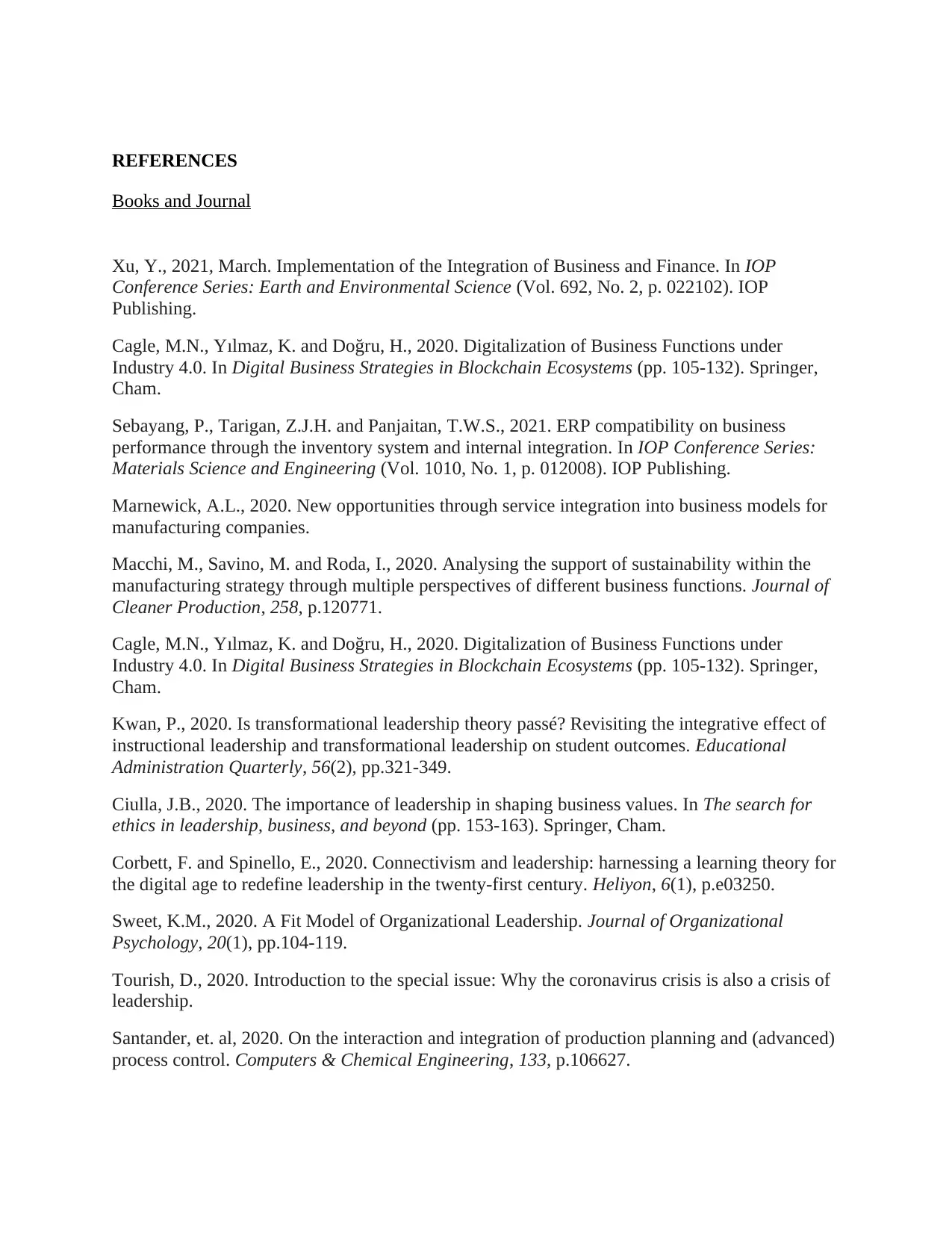
REFERENCES
Books and Journal
Xu, Y., 2021, March. Implementation of the Integration of Business and Finance. In IOP
Conference Series: Earth and Environmental Science (Vol. 692, No. 2, p. 022102). IOP
Publishing.
Cagle, M.N., Yılmaz, K. and Doğru, H., 2020. Digitalization of Business Functions under
Industry 4.0. In Digital Business Strategies in Blockchain Ecosystems (pp. 105-132). Springer,
Cham.
Sebayang, P., Tarigan, Z.J.H. and Panjaitan, T.W.S., 2021. ERP compatibility on business
performance through the inventory system and internal integration. In IOP Conference Series:
Materials Science and Engineering (Vol. 1010, No. 1, p. 012008). IOP Publishing.
Marnewick, A.L., 2020. New opportunities through service integration into business models for
manufacturing companies.
Macchi, M., Savino, M. and Roda, I., 2020. Analysing the support of sustainability within the
manufacturing strategy through multiple perspectives of different business functions. Journal of
Cleaner Production, 258, p.120771.
Cagle, M.N., Yılmaz, K. and Doğru, H., 2020. Digitalization of Business Functions under
Industry 4.0. In Digital Business Strategies in Blockchain Ecosystems (pp. 105-132). Springer,
Cham.
Kwan, P., 2020. Is transformational leadership theory passé? Revisiting the integrative effect of
instructional leadership and transformational leadership on student outcomes. Educational
Administration Quarterly, 56(2), pp.321-349.
Ciulla, J.B., 2020. The importance of leadership in shaping business values. In The search for
ethics in leadership, business, and beyond (pp. 153-163). Springer, Cham.
Corbett, F. and Spinello, E., 2020. Connectivism and leadership: harnessing a learning theory for
the digital age to redefine leadership in the twenty-first century. Heliyon, 6(1), p.e03250.
Sweet, K.M., 2020. A Fit Model of Organizational Leadership. Journal of Organizational
Psychology, 20(1), pp.104-119.
Tourish, D., 2020. Introduction to the special issue: Why the coronavirus crisis is also a crisis of
leadership.
Santander, et. al, 2020. On the interaction and integration of production planning and (advanced)
process control. Computers & Chemical Engineering, 133, p.106627.
Books and Journal
Xu, Y., 2021, March. Implementation of the Integration of Business and Finance. In IOP
Conference Series: Earth and Environmental Science (Vol. 692, No. 2, p. 022102). IOP
Publishing.
Cagle, M.N., Yılmaz, K. and Doğru, H., 2020. Digitalization of Business Functions under
Industry 4.0. In Digital Business Strategies in Blockchain Ecosystems (pp. 105-132). Springer,
Cham.
Sebayang, P., Tarigan, Z.J.H. and Panjaitan, T.W.S., 2021. ERP compatibility on business
performance through the inventory system and internal integration. In IOP Conference Series:
Materials Science and Engineering (Vol. 1010, No. 1, p. 012008). IOP Publishing.
Marnewick, A.L., 2020. New opportunities through service integration into business models for
manufacturing companies.
Macchi, M., Savino, M. and Roda, I., 2020. Analysing the support of sustainability within the
manufacturing strategy through multiple perspectives of different business functions. Journal of
Cleaner Production, 258, p.120771.
Cagle, M.N., Yılmaz, K. and Doğru, H., 2020. Digitalization of Business Functions under
Industry 4.0. In Digital Business Strategies in Blockchain Ecosystems (pp. 105-132). Springer,
Cham.
Kwan, P., 2020. Is transformational leadership theory passé? Revisiting the integrative effect of
instructional leadership and transformational leadership on student outcomes. Educational
Administration Quarterly, 56(2), pp.321-349.
Ciulla, J.B., 2020. The importance of leadership in shaping business values. In The search for
ethics in leadership, business, and beyond (pp. 153-163). Springer, Cham.
Corbett, F. and Spinello, E., 2020. Connectivism and leadership: harnessing a learning theory for
the digital age to redefine leadership in the twenty-first century. Heliyon, 6(1), p.e03250.
Sweet, K.M., 2020. A Fit Model of Organizational Leadership. Journal of Organizational
Psychology, 20(1), pp.104-119.
Tourish, D., 2020. Introduction to the special issue: Why the coronavirus crisis is also a crisis of
leadership.
Santander, et. al, 2020. On the interaction and integration of production planning and (advanced)
process control. Computers & Chemical Engineering, 133, p.106627.
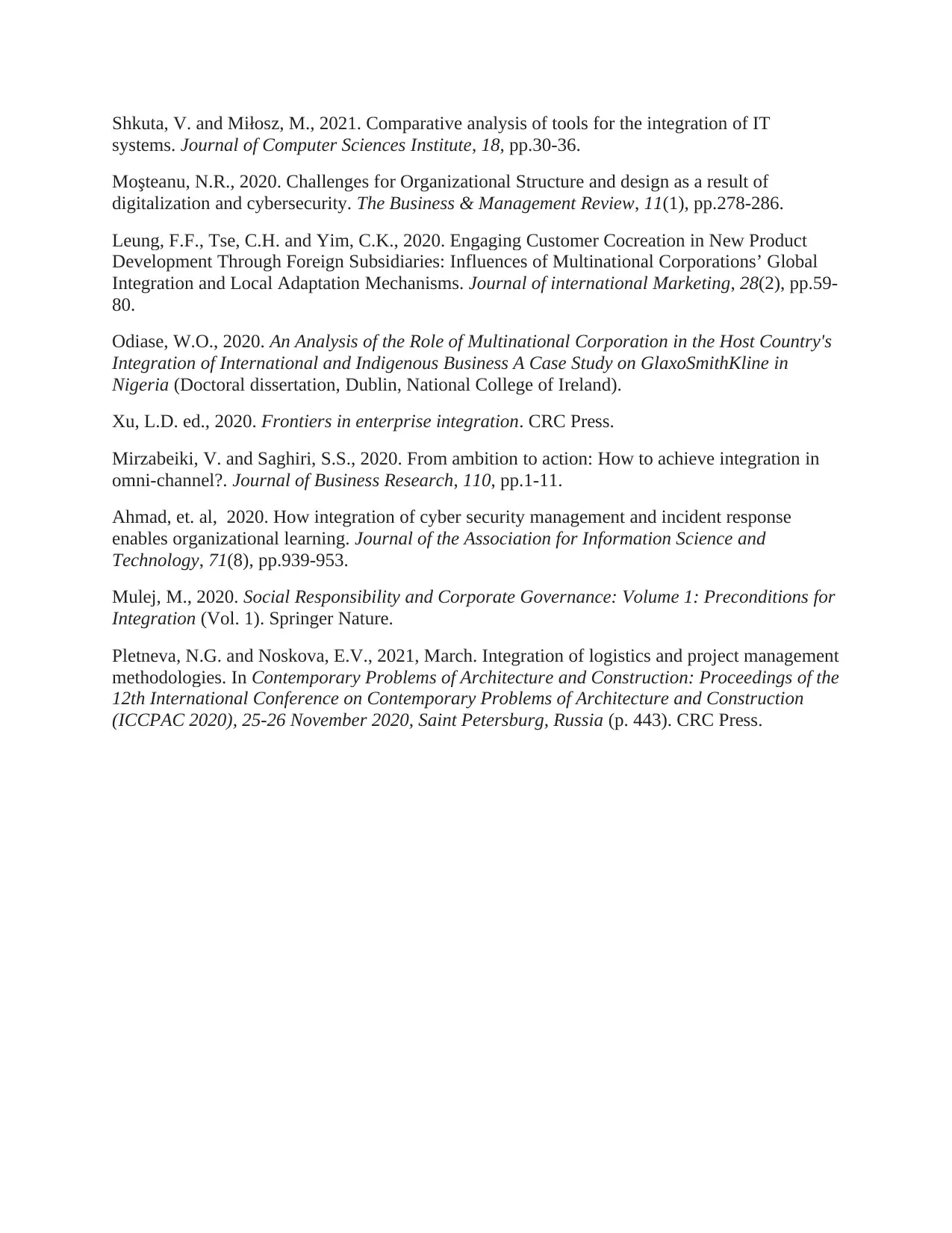
Shkuta, V. and Miłosz, M., 2021. Comparative analysis of tools for the integration of IT
systems. Journal of Computer Sciences Institute, 18, pp.30-36.
Moşteanu, N.R., 2020. Challenges for Organizational Structure and design as a result of
digitalization and cybersecurity. The Business & Management Review, 11(1), pp.278-286.
Leung, F.F., Tse, C.H. and Yim, C.K., 2020. Engaging Customer Cocreation in New Product
Development Through Foreign Subsidiaries: Influences of Multinational Corporations’ Global
Integration and Local Adaptation Mechanisms. Journal of international Marketing, 28(2), pp.59-
80.
Odiase, W.O., 2020. An Analysis of the Role of Multinational Corporation in the Host Country's
Integration of International and Indigenous Business A Case Study on GlaxoSmithKline in
Nigeria (Doctoral dissertation, Dublin, National College of Ireland).
Xu, L.D. ed., 2020. Frontiers in enterprise integration. CRC Press.
Mirzabeiki, V. and Saghiri, S.S., 2020. From ambition to action: How to achieve integration in
omni-channel?. Journal of Business Research, 110, pp.1-11.
Ahmad, et. al, 2020. How integration of cyber security management and incident response
enables organizational learning. Journal of the Association for Information Science and
Technology, 71(8), pp.939-953.
Mulej, M., 2020. Social Responsibility and Corporate Governance: Volume 1: Preconditions for
Integration (Vol. 1). Springer Nature.
Pletneva, N.G. and Noskova, E.V., 2021, March. Integration of logistics and project management
methodologies. In Contemporary Problems of Architecture and Construction: Proceedings of the
12th International Conference on Contemporary Problems of Architecture and Construction
(ICCPAC 2020), 25-26 November 2020, Saint Petersburg, Russia (p. 443). CRC Press.
systems. Journal of Computer Sciences Institute, 18, pp.30-36.
Moşteanu, N.R., 2020. Challenges for Organizational Structure and design as a result of
digitalization and cybersecurity. The Business & Management Review, 11(1), pp.278-286.
Leung, F.F., Tse, C.H. and Yim, C.K., 2020. Engaging Customer Cocreation in New Product
Development Through Foreign Subsidiaries: Influences of Multinational Corporations’ Global
Integration and Local Adaptation Mechanisms. Journal of international Marketing, 28(2), pp.59-
80.
Odiase, W.O., 2020. An Analysis of the Role of Multinational Corporation in the Host Country's
Integration of International and Indigenous Business A Case Study on GlaxoSmithKline in
Nigeria (Doctoral dissertation, Dublin, National College of Ireland).
Xu, L.D. ed., 2020. Frontiers in enterprise integration. CRC Press.
Mirzabeiki, V. and Saghiri, S.S., 2020. From ambition to action: How to achieve integration in
omni-channel?. Journal of Business Research, 110, pp.1-11.
Ahmad, et. al, 2020. How integration of cyber security management and incident response
enables organizational learning. Journal of the Association for Information Science and
Technology, 71(8), pp.939-953.
Mulej, M., 2020. Social Responsibility and Corporate Governance: Volume 1: Preconditions for
Integration (Vol. 1). Springer Nature.
Pletneva, N.G. and Noskova, E.V., 2021, March. Integration of logistics and project management
methodologies. In Contemporary Problems of Architecture and Construction: Proceedings of the
12th International Conference on Contemporary Problems of Architecture and Construction
(ICCPAC 2020), 25-26 November 2020, Saint Petersburg, Russia (p. 443). CRC Press.
⊘ This is a preview!⊘
Do you want full access?
Subscribe today to unlock all pages.

Trusted by 1+ million students worldwide
1 out of 12
Related Documents
Your All-in-One AI-Powered Toolkit for Academic Success.
+13062052269
info@desklib.com
Available 24*7 on WhatsApp / Email
![[object Object]](/_next/static/media/star-bottom.7253800d.svg)
Unlock your academic potential
Copyright © 2020–2025 A2Z Services. All Rights Reserved. Developed and managed by ZUCOL.





